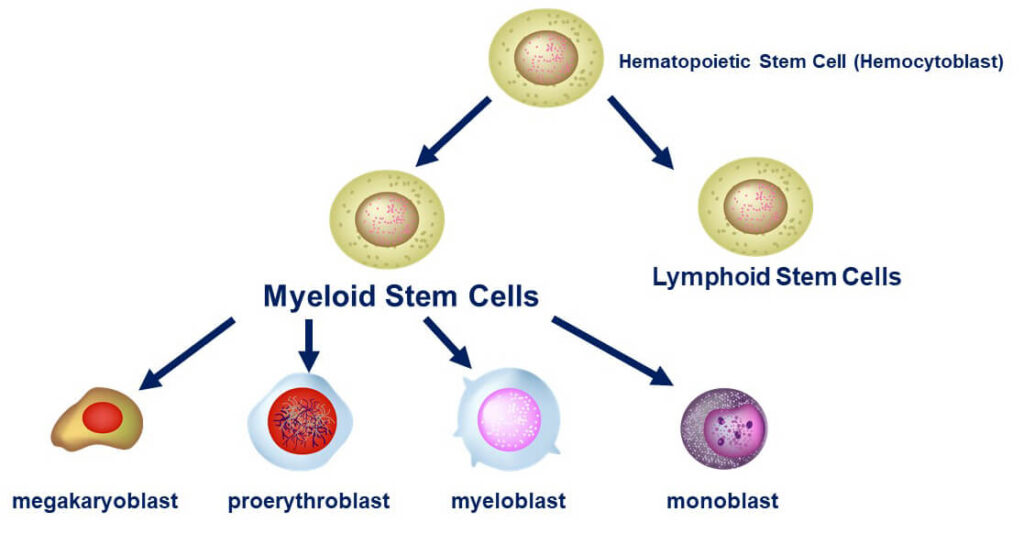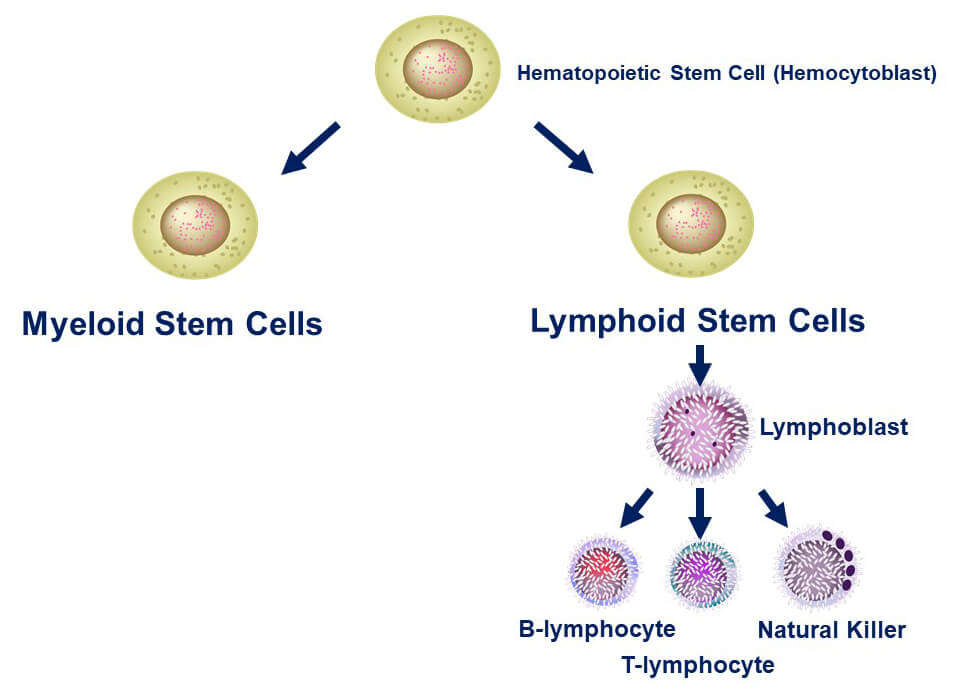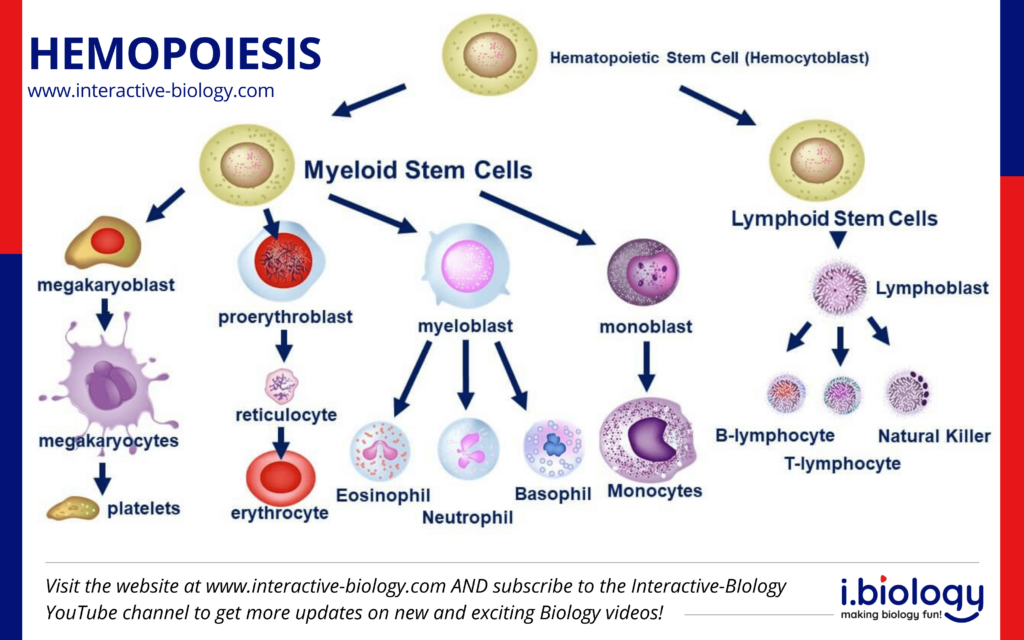We have learned about the different components of the blood. We know that it has red blood cells, white blood cells, and platelets which all serve specific functions and are absolutely necessary to sustain our lives.
Now these cells all need to be made. And the process for making blood cells is called Hemopoiesis.
Topic Outline:
- Where are Blood Cells Made?
- How are Blood Cellls Made?
- Hemocytoblasts – Blood Precursor
- Infographic: Hemopoiesis
Where are Blood Cells Made?
Before we are born, early in the embryo’s development, there’s a structure that’s called a yolk sac. This structure is pretty cool. It helps to nourish the developing embryo. But that’s not all it does.

It’s actually one of the early sites of hemopoiesis. As the embryo develops, hemopoiesis starts happening in structures like the liver, the spleen, and eventually the red bone marrow. By the time a child becomes an adult, most of the hemopoiesis happens in the red bone marrow.

How are Blood Cells Made?
Regardless of where it takes place, the process of HOW it all happens is pretty similar. It all starts with stem cells. Stem cells are cells that have the ability to become different kinds of cells – depending on different factors. The fancy word that we use to describe this ability is pluripotent.
As these stem cells begin to differentiate, they give rise to a new kind of cell – the mesenchymal cell. This is a cell type that can differentiate into cells that form bone, blood, and other kinds of connective tissue.
For those mesenchymal cells that are destined to become blood cells, they develop into a type of cell that we call the hematopoietic stem cell – or hemocytoblast.
Let’s break this word apart really quick:

The first part of the word is hemo. Whenever you see the prefix hem-, hemo- or hemato-, you know you’re dealing with something related to blood. For example – hemoglobin. That’s a protein complex in the blood that’s responsible for carrying oxygen. Or, hematocrit – which refers to the ratio of the volume of red blood cells to the total volume of blood.
Then you have cyto-. When you see that, you know you’re dealing with cells. For example, the cytoplasm is the plasma or fluid inside the cell.
And, when you see the suffix -blast, you know you’re dealing with an immature cell or a precursor cell. Something that will develop into something else. So, a hemocytoblast is a precursor to a blood cell. It’s a cell that can become a blood cell.
Hemocytoblasts – Blood Precursor
The actual process of hemopoiesis starts with hemocytoblasts. They can either divide and make other hemocytoblasts or depending on the environment they find themselves in, they can differentiate into one of two kinds of cells: either into myeloid stem cells or into lymphoid stem cells.

Lymphoid Stem Cells → Lymphocytes
Lymphoid stem cells are the ones that will give rise to the lymphocytes. These are the white blood cells that are part of the immune system.
The way this happens is that the lymphoid stem cells will give rise to lymphoblasts. By now, you should understand that lymphoblasts are cells that are the precursors to lymphocytes. And that’s exactly what we get.
They can become B and T lymphocytes – also known as the B cells and T Cells or it can become Natural Killer cells. These are white blood cells that are involved with the immune system.
The B cells are the ones that produce antibodies that help to protect us from things like viruses and bacteria. They help us attack the viruses.
The T cells on the other hand, are involved with what’s called cell-mediated immunity. We’ll get into the differences between the two in a later video.

One more thing to add is that these cells don’t develop in the bone marrow. In fact, the lymphoid stem cells will move from the bone marrow to parts of the lymphatic system – things like the lymph nodes, the spleen, and the thymus and that’s where they are stimulated to differentiate into the cells we just spoke about.
Myeloid Stem Cells → all other blood cells and fragments
The myeloid stem cell can differentiate into one of four cell types. These are the:
- Megakaryoblast
- Proerythroblast
- Myeloblast
- Monoblast

I know – this is a lot to remember. It’s one of those things that I recommend you just take a pencil and paper and just draw it out over and over – starting with the hematopoietic stem cell and making your way all the way down.
Here’s how these cells continue their differentiation.
Megakaryoblasts → Platelets
The megakaryoblast will differentiate to become a pretty large cell called a megakaryocyte. Think mega – large. Once these megakaryocytes are fully mature, they will then produce the platelets – the fragments involved in blood clotting — yes, the ones that prevent you from bleeding to death when you get a cut.
Proerythroblasts → Erythrocytes
Now the proerythroblast will then lose its nucleus and go through some more differentiation to become a reticulocyte, and the reticulocyte will further go through some differentiation to become the erythrocyte.
Remember? Your erythrocytes are your red blood cells. This is how we get red blood cells.
Myeloblasts → Basophils, Neutrophils, or Eosinophils
The myeloblast can differentiate into three different cells – Basophils, neutrophils or eosinophils. These are three types of white blood cells that we call the granulocytes and you can tell that they are granulocytes because if you look at them under a microscope, you’ll see these little dots or granules inside the cells.
Monoblasts → Monocytes
And lastly, we have the monoblast. This one’s easy. Monoblasts become monocytes. That’s it. Another white blood cell. Yes, it’s involved in the immune system.
Summary
We now have all of the formed elements of the blood– B and T cells, natural killer cells (all three from the lymphoid stem cell), and then the ones that come from the myeloid stem cells– the monocytes, eosinophils, neutrophils, basophils, erythrocytes and the platelets from the Megakaryocytes.
I know it’s a lot of stuff. Try to chart it out a few times, you’re going to get it – and then you’ll feel even smarter. 😉
In the next article, we’re going to dig into the red blood cell in more detail.


